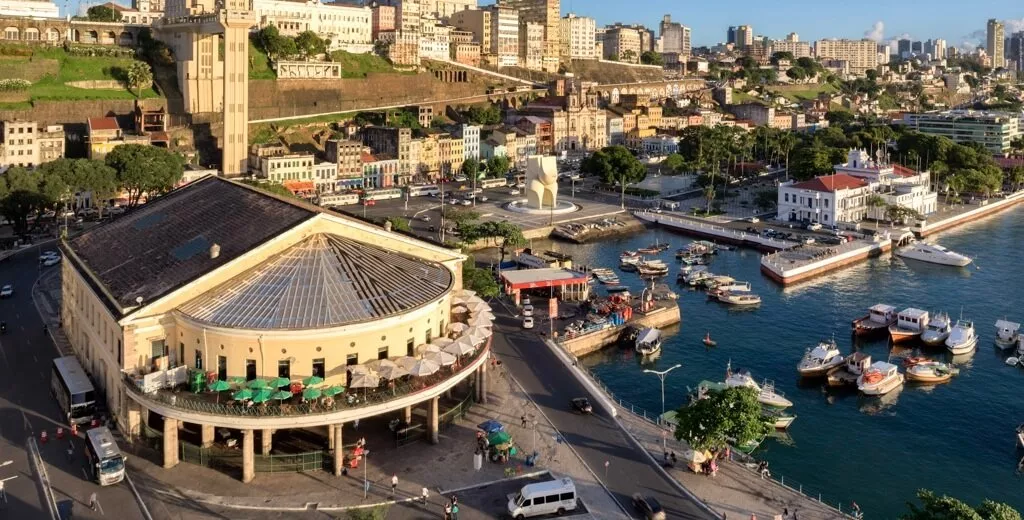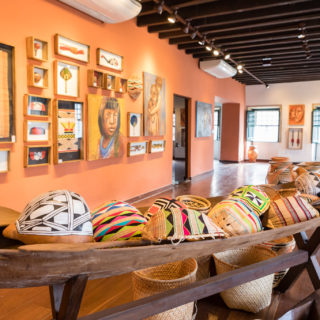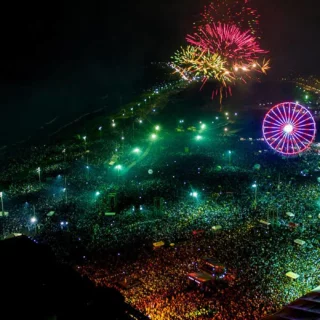
Movies that show you the best of this city!
Brazil’s first capital, founded on March 29, 1549, is also a pioneer in Brazilian audiovisual. Renowned filmmakers, actors and films made in Salvador are considered classics for national cinema. But not everyone has seen the documentaries that show the city’s history.
Much more than a cradle of brilliant minds – ranging from cinema to music and photography – the palm oil land is known for its natural beauty, colors, flavors, sounds and, of course, the religious syncretism of the friendly population. There are also stories of resilience and resistance.
With that in mind, we have prepared a list of ten documentaries available online for you who want to know more about the Salvador’s history. Watch it!
1 – Salvador 450 anos de História (1988)
Launched in 1988, the documentary Salvador 450 anos de História has 53 videos to tell the story of Bahia’s capital. The film begins by narrating what Tomé de Souza (1503-1579), Brazil’s first governor-general, saw when he landed in Bahia on March 29, 1549, with an “ouvidor-mor”, in charge of justice, a “provedor-mor”, responsible for finance, the major-captain of the coast, who headed the colony’s defending militia against non-Portuguese interests, and six Jesuits under the guidance of Manuel da Nóbrega. The documentary was directed by Lauro Passos. The initiative and research are by journalist Nelson Cadena.
2 – Mosteiro de São Bento da Bahia (1998)
Founded in Salvador in the year 1582, the Monastery of São Bento da Bahia, in Barroquinha, was the first Benedictine institution built in American lands and the first to be kept outside Europe. In this documentary – released in 1998 to celebrate the fourth centenary of the monastery foundation – you can learn more about the religious role of the institution that spread the Catholic faith in Salvador for many years. The documentary also highlights its historical importance through documents, old maps of the Bahian capital, plans, drawings and views. The direction is by Lauro Passos; photograph by Rogério Sampaio; the adapted script is by Soraya Publio de Castro Mesquita and the original text is by Jorge Luiz Magalhães Souza.
3 – Breve História das Capitais Brasileiras – Salvador (2007)
The documentary is part of TV Escola’s Breve História das Capitais Baianas (Brief History of Brazilian Capitals) series, and tells the story of Salvador city in an iconographic way, from watercolors, prints, photographs and other historical documents existing in the country’s museums and public collections. It allows reflections about the local and regional continuances and changes.
4 – Arte no Espaço (2009)
When it comes to the relationship that Salvador and Bahia have with Africa, Pierre Verger is one of the most representative references. The documentary Arte no Espaço honors the photographer’s life and work, showing relevant facts from his biography and using testimonies from those who lived with him or who followed his ideals. Friends, members of Espaço Cultural and the Pierre Verger Foundation, as well as scholars, such as historian Cid Teixeira, enrich the film by recalling situations, highlighting the importance of his work, showing how Verger guided dreams and awakened the recognition and identification of people with their own culture. Through his work, he helped the Engenho Velho da Federação community to recognize and identify with its history, strengthening its own culture. The documentary also shows the Pierre Verger Cultural Space, which has as one of its objectives the continuation of Verger’s work, through workshops which main theme is art and education. Directed and produced by Caroline Fantinel.
Part 1
Part 2
5 – História Secreta Bahia (2012)
A 2012 episode from The History Channel became the documentary História Secreta Bahia. The video shows the Bahian singer Pitty on a revealing tour through Salvador city. História Secreta shows that, behind its postcards, religious syncretism and its famous Carnival, there are curious tales that refer to the Portuguese conquests and the slaves presence. The main sights of the city, the best known popular festival in the country and the most striking characters of Bahian culture are analyzed.
Among the curiosities revealed by Pitty are the past of Pelourinho narrow streets, the origin of Farol da Barra, the controversy surrounding the Lacerda Elevator construction and the mysteries surrounding the Mercado Modelo. The creators of Trio Elétrico and other important figures, such as the poet Castro Alves and the mother-of-saint Menininha de Gantois are also part of the city’s history.
6 – Guerra da Independência na Bahia (2012)
Brazil’s independence was not received in the same way across the country. The documentary miniseries Guerra da Independência na Bahia details the conflicts that occurred between Portuguese and Brazilians in the region, which ended on July 2, 1823 with the Brazilian victory and the definitive political rupture between Brazil and Portugal.
With a rich collection of historical and current images, interviews with Bahian historians and scenes from the popular celebration of the 2nd of July, the documentary explains why Bahia celebrates independence on another date. Direction and executive production are by Renato Barbieri; research and script by Victor Leonardi; and the narration by Zezé Motta. The production is from TV Escola in partnership with GAYA Filmes.
7 – Mocambo Akomabu (2014)
The Alto do Tororó Community, located in São Tomé de Paripe, in the Salvador Railway Suburb, is the main character of the documentary Mocambo Akomabu. The film tells the story of the place, which was once Quilombo do Alto do Tororó, and which has the characteristic of being a traditional urban, fishing, extractive and candomblé community.
The documentary mixes testimonies from community leaders in Alto do Tororó and political actors on the agenda of racial equality, with animated scenes and coverage images that bring out the particularities of this Quilombola Community. The film also shows a conflict that the community has with the Brazilian Navy, which set up the Naval Base in the region in the 1940s, and which, since then, has not recognized the neighboring quilombola communities as the territory owners. The film is directed by João Paulo Diogo.
8 – Axé – Canto do Povo de um Lugar (2016)
Launched in October 2016, Axé – Canto do Povo de um Lugar is the first film by Bahian Chico Kertész. The documentary recalls the history of Axé Music’s musical movement – which carries in its essence a good part of all Bahian musical and cultural syncretism – and gathers testimonies by Caetano Veloso, Ivete Sangalo, Gilberto Gil, Daniela Mercury, among other artists.
The film stands out for the collection of photographic and audiovisual material made by James Martins, in charge of the research. Among the scenes, it is possible to watch Luiz Caldas’ first participation at Cassino do Chacrinha, in 1986, singing “Fricote”. It also shows Ivete Sangalo’s farewell from Banda Eva; Sarajane’s presence in the Chacrinha Program; and the memories of Caetano Veloso and Daniela Mercury about the first time they heard Olodum. Click here to watch.
9 – Toponímia da Cidade do Salvador (2018)
Narrated by Cid Teixeira, the documentary Toponímia da Cidade do Salvador is a reinterpretation of the radio program of the Instituto de Radiodifusão Educativa da Bahia (Educational Radio Broadcasting Institute of Bahia – IRDEB), made by the historian in 1975, and released in 2018. Directed by documentary filmmaker Carolina Canguçu, the work brings explanations, curiosities and the origin of the names of famous places in the city such as Pelourinho, Sete Portas, Baixa dos Sapateiros, Subúrbio, Ladeira dos Galés, Church of the Rosary of the Black People, among others.
As part of the celebration of Rádio Educadora FM’s 40th anniversary, the project emerged from research and, consequently, digitalization of the material extracted from the Documentation Center (CEDOC) of TVE, in addition to the original audios of the historian’s program.
10 – Zeferinas – Guerreiras da Vida (2019)
The quilombola warrior leader Zeferina, who lived in the capital of Bahia in the 19th century, is synonymous with resistance and freedom for men and women. Almost 200 years later, the ‘Zeferinas’ are different, but the libertarian ideal and the struggle remain.
Warriors like the hundreds of women who lived in the old Plastic City and now live in the housing complex named after the leader in Periperi. Represented by four of them – Cassileide Bonfim, 42, Miriã Santos, 37, Tâmara Duarte, 29 and Vanderlice Reis, 76 – they star in the documentary Zeferinas – Guerreiras da Vida, which was released in 2019.
The medium-length film tells, in approximately 25 minutes, the lives of these women, who have stories of overcoming, and draws a parallel with the trajectory of Zeferina, heroine of the past. With exciting interviews, in addition to strong images of the old Plastic City and the landscape that makes up the current reality of the “Zeferinas”, the documentary rescues this link, showing the greatest conflicts in the trajectory of each “warrior” who inhabits the place, which is along the railroad tracks.

















